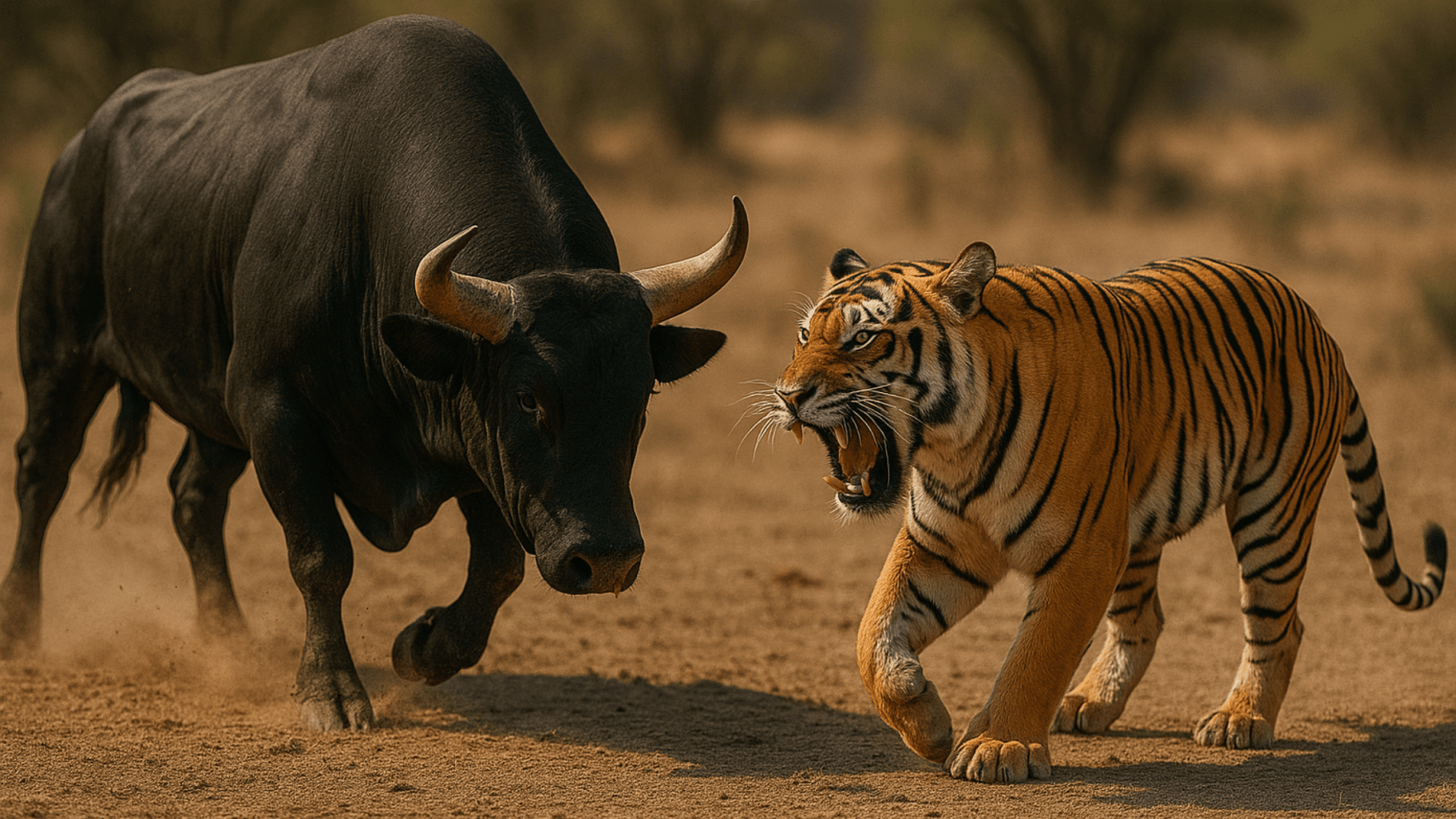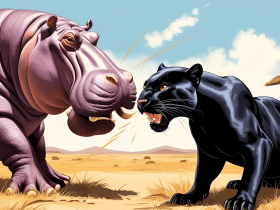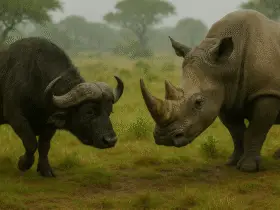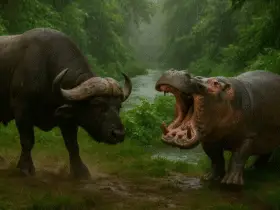Bull vs Tiger fight—a battle between brute force and deadly perfection. The bull, a symbol of the raw power and resilience, stands its ground with immense strength and sharp horns. The tiger, a solitary apex predator, strikes with stealth, speed, and a killing bite honed by evolution. While these two animals rarely meets in the wild, Just imagine what will happen if they engaged to a face to face fight: Can the tiger’s hunting power overcome the bull’s size and aggression? Or will the bull’s power prove that it can take down the most formidable big cat?
But who would win in a real confrontation? Let’s break this down in a scientific data comparison of Bull Vs Tiger Fight.
Keep reading till the end to learn about these two creatures. Enjoy!
1. Body Specifications
| Subtopic | Bull (Bos taurus) | Tiger (Panthera tigris) | Winner |
|---|---|---|---|
| Average Height | 1.5 – 1.8 meters at shoulder | 0.9 – 1.1 meters at shoulder | Bull |
| Average Length | 2.4 – 3.5 meters (including tail) | 2.7 – 3.3 meters (with tail) | Draw |
| Weight Range | 600 – 1,200 kg (varies by breed) | 100 – 310 kg (Siberian is largest) | Bull |
| Body Shape | Stocky, barrel-chested, broad frame | Sleek, muscular, elongated body | Draw |
| Muscle Mass | High; mainly slow-twitch fibers | High; fast-twitch explosive fibers | Tiger |
| Bone Density | Very dense bones for impact resistance | Less dense, more agile skeleton | Bull |
| Horns | Present; 30–100 cm long | None | Bull |
| Skull Thickness | Extremely thick forehead | Moderate skull density | Bull |
| Center of Gravity | Low, aiding in balance and charge power | Medium, designed for pouncing and leaping | Bull |
| Physical Build Type | Power-based | Power-speed hybrid | Draw |
Category Winner: Bull – Bigger, heavier, and structurally built for brute power.
2. Coat and Coloration
| Subtopic | Bull | Tiger | Winner |
|---|---|---|---|
| Coat Color | Black, brown, white, spotted (breed-specific) | Orange with black stripes | Tiger |
| Pattern | Usually uniform or mottled | Camouflage striping for stealth | Tiger |
| Seasonal Changes | Minimal coat variation | Slightly denser in colder regions | Tiger |
| Camouflage Ability | Very low | Very high – perfect for stalking prey | Tiger |
| Hair Density | Medium | Thick and coarse | Tiger |
| Melanin Expression | Controlled by breed | Some melanistic (black tigers) cases exist | Tiger |
| Coat Function | Temperature regulation | Stealth + warmth | Tiger |
| Maintenance Needs | Groomed or cleaned by humans | Self-groomed | Tiger |
| Sunlight Protection | Limited | Striped pattern breaks silhouette in light | Tiger |
| Predator Adaptation | None (not a predator) | Fully optimized for predation | Tiger |
Category Winner: Tiger – Superior coat for hunting, camouflage, and environmental adaptation.
3. Habitat and Range
| Subtopic | Bull | Tiger | Winner |
|---|---|---|---|
| Natural Range | Domesticated globally | Asia: India, Russia, SE Asia | Tiger |
| Habitat Type | Farmland, pasture, human settlements | Forests, grasslands, mangroves | Tiger |
| Climate Preference | Temperate to tropical | Tropical, temperate, subarctic | Tiger |
| Geographic Flexibility | High (due to domestication) | Moderate – habitat-specific | Bull |
| Shelter Use | Barns or open pastures | Dens, thickets, caves | Tiger |
| Altitude Range | Sea level to 3,000 m | Sea level to 4,000 m | Tiger |
| Range Size | Human managed | Up to 1,000 km² (Siberian) | Tiger |
| Migration Behavior | None | None (territorial) | Draw |
| Water Dependency | High | High (also swims well) | Tiger |
| Human Proximity | Fully integrated with humans | Avoids humans | Bull |
Category Winner: Tiger – Wild adaptability, survival across diverse ecosystems.
4. Diet and Hunting
| Subtopic | Bull | Tiger | Winner |
|---|---|---|---|
| Diet Type | Herbivore (grass, hay, grains) | Obligate carnivore | Tiger |
| Hunting Technique | None | Stalk, ambush, kill with throat bite | Tiger |
| Prey Preference | N/A | Deer, boar, buffalo, sometimes cattle | Tiger |
| Daily Caloric Intake | 20,000–30,000 kcal (from plants) | 6,000–12,000 kcal (from meat) | Draw |
| Feeding Frequency | Regularly throughout the day | 1 major kill every few days | Draw |
| Weapon Usage | Uses horns when provoked | Uses claws and 6–7 cm canines | Tiger |
| Offensive Capacity | Very low (not a predator) | High – evolved to kill | Tiger |
| Digestive System | 4-chambered rumen | Simple carnivorous system | Draw |
| Hunting Success Rate | N/A | 20–30% success rate | Tiger |
| Threat to Livestock | None | High (preys on cattle in some areas) | Tiger |
Category Winner: Tiger – A true apex predator with evolved hunting tools.
5. Strength and Bite Force
| Subtopic | Bull | Tiger | Winner |
|---|---|---|---|
| Bite Force (PSI) | 300–400 PSI (if agitated) | ~1,050 PSI | Tiger |
| Claw Strength | None | 10 cm claws; capable of shredding bone | Tiger |
| Lifting Capacity | Limited to pushing with head or horns | Can drag 2x body weight | Tiger |
| Headbutt Force | Extremely high (used for charging) | Not applicable | Bull |
| Overall Muscle Strength | High – dense musculature | Explosive strength | Draw |
| Trampling Force | Strong – especially with hooves | Moderate (uses swiping and mauling) | Bull |
| Killing Tools | Horns, weight | Jaws, claws, agility | Tiger |
| Neck Strength | Strong (for ramming and lifting) | Strong (for dragging prey) | Draw |
| Power Output | High sustained power | High burst power | Tiger |
| Attack Speed | Slow attack initiation | Lightning-fast swipes and lunges | Tiger |
Category Winner: Tiger – Deadlier in direct combat due to weapons and precision.
6. Speed and Agility
| Subtopic | Bull | Tiger | Winner |
|---|---|---|---|
| Top Speed | 40–50 km/h | Up to 65 km/h | Tiger |
| Acceleration | Slow, gradual | Explosive; reaches top speed in seconds | Tiger |
| Agility (Land) | Poor; not agile due to bulk | High – excellent lateral movement | Tiger |
| Agility (Water) | Cannot swim well | Strong swimmer | Tiger |
| Jumping Ability | Very low | Can leap up to 10 meters horizontally | Tiger |
| Turning Radius | Wide | Tight – quick pivots | Tiger |
| Stamina (Short-term) | High for short bursts | Moderate | Bull |
| Stamina (Long-term) | Moderate | Moderate to high | Draw |
| Reflexes | Slow | Lightning-fast reflexes | Tiger |
| Combat Mobility | Poor – limited to forward charge | High – strikes from multiple angles | Tiger |
Category Winner: Tiger – Far superior in speed, mobility, and combat agility.
7. Senses – Bull Vs Tiger Fight
| Subtopic | Bull | Tiger | Winner |
|---|---|---|---|
| Vision (Day) | Moderate | Excellent, color-sensitive | Tiger |
| Vision (Night) | Poor night vision | Superior – adapted for low light | Tiger |
| Hearing Range | Good; sensitive to loud or sudden noises | Excellent directional hearing | Tiger |
| Sense of Smell | Very good | Exceptional – key in tracking prey | Tiger |
| Echolocation | None | None | Draw |
| Spatial Awareness | Limited – frontal awareness | Excellent – full body spatial sense | Tiger |
| Depth Perception | Weak | Excellent – critical for pouncing | Tiger |
| Heat Detection | None | Not specialized | Draw |
| Alertness Level | Moderate; alert to danger | Very high – always vigilant in wild | Tiger |
| Reaction to Threats | Charges blindly | Stalks, retreats, or counters with precision | Tiger |
Category Winner: Tiger – Sharper senses in all aspects, crucial for survival and attack.
8. Reproduction and Lifespan
| Subtopic | Bull | Tiger | Winner |
|---|---|---|---|
| Sexual Maturity Age | 12–15 months | 3–5 years | Bull |
| Gestation Period | ~280 days | ~105 days | Tiger |
| Offspring per Birth | 1 calf | 2–4 cubs | Tiger |
| Weaning Age | 6–8 months | 5–6 months | Draw |
| Parental Care | None by males | Mothers raise cubs for 2 years | Tiger |
| Cub Mortality Rate | Low (under human care) | High (up to 50% in wild) | Bull |
| Lifespan (Wild) | N/A (domestic) | 10–15 years | Tiger |
| Lifespan (Captivity) | 15–20 years | 20–26 years | Tiger |
| Reproductive Frequency | Controlled breeding | 1 litter every 2–3 years | Bull |
| Reproductive Role | Sires many calves | Solitary breeder | Bull |
Category Winner: Draw – Bulls are bred more frequently, but tigers excel in parental investment and wild adaptation.
9. Social Behavior
| Subtopic | Bull | Tiger | Winner |
|---|---|---|---|
| Social Structure | Herd animals (in natural or farm settings) | Solitary, highly territorial | Bull |
| Territorial Behavior | Minimal; can be aggressive in mating season | Very territorial; scent marks & patrols | Tiger |
| Group Defense | Strong when in herd | Fights alone | Bull |
| Communication | Grunts, bellows | Roars, chuffing, growls | Tiger |
| Aggressiveness | High when provoked or challenged | Calculated aggression | Draw |
| Parental Involvement | None (males) | Mothers highly protective | Tiger |
| Social Intelligence | Low | Moderate – recognizes individuals | Tiger |
| Play Behavior | Minimal | Cubs are highly playful | Tiger |
| Hierarchical Nature | Present in herds | Individual territories | Draw |
| Behavioral Flexibility | Rigid (domesticated roles) | Highly adaptive to situation | Tiger |
Category Winner: Tiger – Greater behavioral complexity and adaptability.
10. Conservation Status – Bull Vs Tiger Fight
| Subtopic | Bull | Tiger | Winner |
|---|---|---|---|
| IUCN Status | Not evaluated (domesticated) | Endangered (IUCN Red List) | Bull |
| Population Trend | Stable; increasing | Decreasing overall | Bull |
| Threats Faced | None in wild (fully domesticated) | Poaching, habitat loss, human conflict | Bull |
| Habitat Loss Impact | None | Major cause of decline | Bull |
| Breeding Programs | Abundant worldwide | In place but challenging | Bull |
| Legal Protections | Farming regulations | CITES Appendix I | Tiger |
| Role in Ecosystem | None (domesticated) | Apex predator – key to balance | Tiger |
| Human Interaction | Extensive | Limited; often leads to conflict | Bull |
| Captive Numbers | Millions | Estimated 10,000 globally | Bull |
| Risk of Extinction | None | High in certain subspecies | Bull |
Category Winner: Bull – No conservation threat; tigers remain critically endangered.
Interesting Facts – Bull Vs Tiger Fight
Bull
-
Bulls are very strong and much heavier than cows.
-
They have thick necks, big heads, and strong, short horns.
-
Bulls can weigh over 2,000 pounds and have a hump on their shoulders.
-
Their bones and muscles are built for power and fighting.
-
Bulls are aggressive, especially when challenged.
-
They use their horns to defend themselves and fight for dominance.
-
Bulls have curly hair on their neck and head for extra protection.
-
They eat grass and are herbivores.
-
Bulls have great stamina and can run surprisingly fast for their size.
Tigers
-
Tigers are the biggest wild cats in the world.
-
They can weigh up to 670 pounds and grow up to 11 feet long.
-
Tigers have unique stripes, like fingerprints—no two are the same.
-
They are powerful hunters and can leap up to 33 feet in one jump.
-
Tigers love water and are strong swimmers.
-
They hunt alone and use stealth to sneak up on prey.
-
Tigers can eat up to 75 pounds of meat in one meal.
-
Their roar can be heard over 3 kilometers away.
-
Tigers are endangered and live mostly in Asia.
-
Cubs stay with their mother for up to two years.
Face-to-Face Fight Analysis: Bull vs Tiger Fight
In a real bull vs tiger fight, several scenarios emerge:
- Strength and size: The bull has a major advantage in sheer size and mass. A single attack could severly injure a tiger.
- Agility and strategy: The tiger has stealth, reflexes, and deadly precision. It could attack from behind or leap onto the bull’s back.
- Defensive armor: The bull’s thick skull and horns provide natural defense, especially from frontal attacks.
- Combat intelligence: The tiger is more tactical, targeting weak spots like the neck or underbelly.
In the wild, tigers have been known to prey on domestic cattle but would rarely attack a healthy full-grown bull.. Tigers more like to ambush from behind or attack calves.
Final Verdict: Who Wins the Bull vs Tiger Fight?
| Winner: Tiger |
In the bull vs tiger fight, the tiger is more likely to win—but it would be a tough and dangerous battle for both.
-
What happens in the fight – The bull’s size and horns make it a dangerous opponent. If the tiger can’t get a bite on the bull’s neck or is caught by the horns, it could be badly hurt or even killed. But tigers are skilled at dodging attacks and using their agility to wear down large prey. Over time, the tiger’s repeated attacks would likely weaken the bull, allowing the tiger to go for a fatal bite
Reasons Tiger Wins:
- Superior agility and combat reflexes.
- Deadly weapons: claws, jaws, and strategy.
- Can strike vital areas with surgical precision.
- History of killing bovines (especially in India and Siberia).
Why the Bull Loses:
- Too slow and bulky for a dynamic predator.
- No offense beyond charging and trampling.
- Vulnerable flanks and neck region.
- Lacks adaptability in one-on-one predator fights.
So what do you think? Who will win?
Don’t forget to leave a comment!
References: Bull Vs Tiger Fight
- Sunquist, M., & Sunquist, F. (2002). Wild Cats of the World. University of Chicago Press.
- IUCN Red List: Panthera tigris – https://www.iucnredlist.org/
- Nowak, R. M. (1999). Walker’s Mammals of the World (6th ed.).
Read More – Asian Elephant vs Tiger : Brutal Sci-fi Breakdown






your explanations are excellent. !!